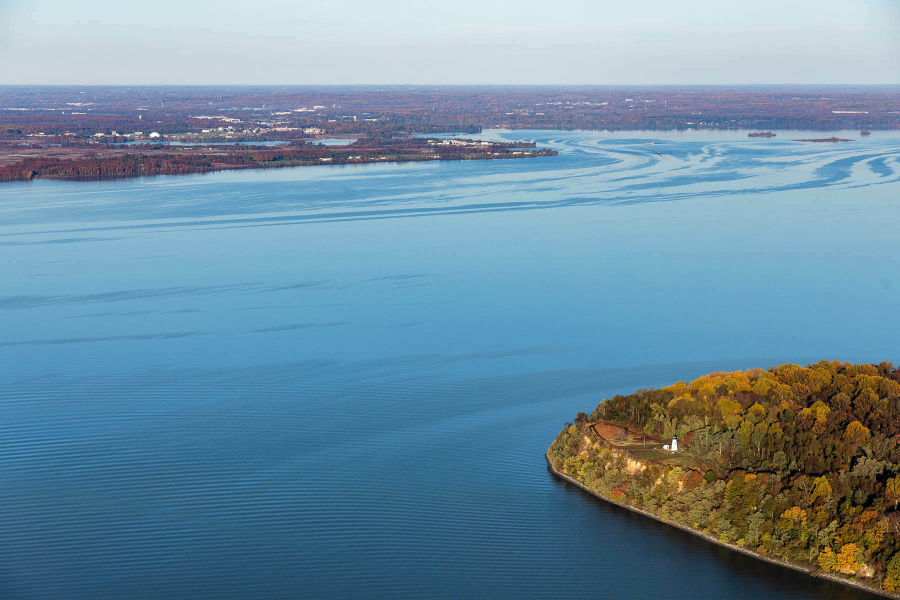Experts find an average Chesapeake Bay dead zone in 2021
Hot weather and mild winds contribute to the dead zone sticking around longer into the fall

The Chesapeake dead zone forms annually as a consequence of the amount of pollution—particularly nitrogen and phosphorus—that enters the Bay from its watershed. But it is the weather that impacts its spread and how long it will last each year. Meaning that if climate change continues to negatively impact the Bay, the dead zone may stay around even longer and become more severe in the years to come.
The “dead zone” is an area of little to no oxygen that forms in Bay waters when excess nitrogen and phosphorus, otherwise referred to as nutrients, enter the water through polluted runoff and feed naturally-occurring algae. This causes algae blooms to grow and then eventually die off and decompose. When they decompose, the process removes oxygen from the surrounding waters faster than it can be replenished. This creates low-oxygen, or hypoxic, conditions at the bottom of the Bay. Plant and animal life are often unable to survive in this environment, which is why the area is referred to as a “dead zone”.
The main way in which nutrients can enter the Bay is through polluted runoff flowing from its tributaries around the watershed. When our region experiences more—and possibly heavier--rainfall throughout the year, river flows will be higher and faster, increasing the amount of pollution. While the spring of 2021 saw average rainfall and lower river flows, the U.S. Geological Survey (USGS) actually found that the overall average for the water year (October 1, 2020—September 30, 2021) was higher than normal, with flows entering the Bay around 84,880 cubic feet per second. To put that into perspective, an average-sized bathtub holds approximately 5.6 cubic feet of water (42 gallons). That’s the equivalent of 15,118 bathtubs being emptied into the Bay each second.
Based on this past spring’s rainfall, Chesapeake Bay Program experts forecasted that the 2021 dead zone would be slightly smaller than average. For the past 14 years, a model developed by the University of Michigan has been used to estimate the volume of summer hypoxia for the mainstem of the Chesapeake Bay based on the amount of pollution flowing into the Bay from its tributaries from the previous January—May. This model is also informed by data provided by the Chesapeake Bay Program, Maryland Department of Natural Resources (MD DNR), Virginia Department of Environmental Quality (VA DEQ) and USGS.
Throughout the year, researchers track hypoxia using a variety of methods. Oxygen and nutrient levels are measured as part of the Chesapeake Bay Monitoring Program, a Bay-wide cooperative effort involving states, federal agencies, 10 academic institutions and over 30 scientists. The MD DNR, VA DEQ and Old Dominion University conduct nine monitoring cruises between May—October to track summer hypoxia in the Bay. In 2021, they found the dead zone to be slightly below average.
Scientists from the Virginia Institute of Marine Science (VIMS), in collaboration with Anchor QEA, use computer models combined with local weather information to produce daily, real-time estimates of the size of the dead zone throughout the summer. Over the past year, they found the summer dead zone to be slightly more extensive than average. They believe this is due to how long the 2021 dead zone lasted.
Overall, the duration of the 2021 dead zone was 89% longer than those recorded over the past 36 years. Here’s where the weather comes into play again. Hypoxic conditions thrive in high temperatures with low winds. And that’s exactly what the Bay experienced from July through September. In fact, the months of August and September were recorded as the fifth hottest on record for the state of Maryland, according to the National Oceanic and Atmospheric Administration’s National Centers for Environmental Information. Even with the passing of Hurricane Ida in September, the dead zone remained above average in size.
“This year’s estimate of the Chesapeake’s dead zone illustrates the challenge between Chesapeake Bay Program management actions and climate change that brings increased volume and river flows,” said Michelle Price-Fay, acting director of the Environmental Protection Agency’s Chesapeake Bay Program Office. “While the long-term trend is toward a reduction in hypoxia due to management actions taken throughout the watershed, warming from climate change is a headwind that may increase hypoxia’s duration and extent.”
While you may not be able to control the weather, there are actions you can take to control the amount of nutrient pollution entering the Bay and to help slow the rise of climate change.
- Purchase phosphate-free or biodegradable products for cleaning your house or washing your clothes.
- Consider using Bay-friendly pesticides in your garden or yard, and if it spills or leaks, don’t use a hose to clean up. Rather, soak the liquid up with an absorbent material like sawdust or kitty litter, then sweep it into a bag and clean the area with a mixture of water and bleach.
- Look into using toxic-free personal products, such as eco-friendly lotions, cosmetics and perfumes. This can keep toxic chemicals from washing off your body and into our waterways.
- Use boiling water to kill weeds and other pests, rather than use chemical pesticides in your garden or yard.
Looking for more ways to help? Check out our How-Tos and Tips page.

Comments
There are no comments.
Thank you!
Your comment has been received. Before it can be published, the comment will be reviewed by our team to ensure it adheres with our rules of engagement.
Back to recent stories